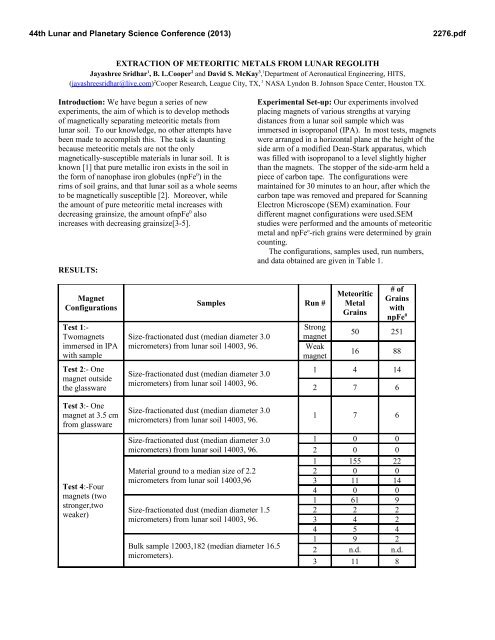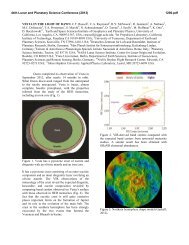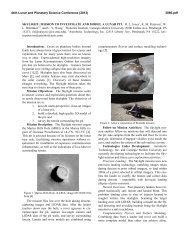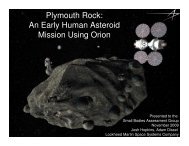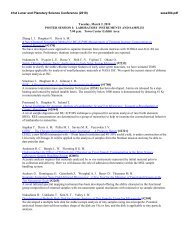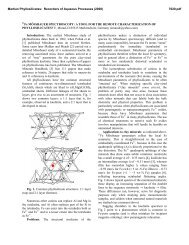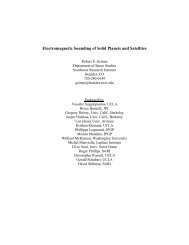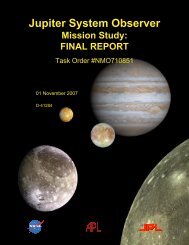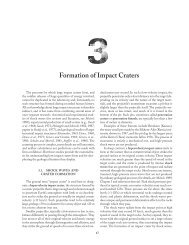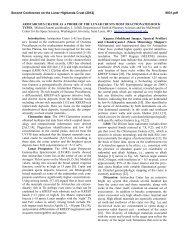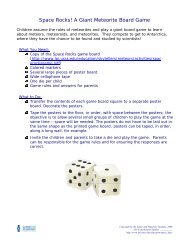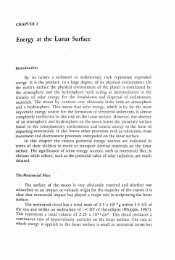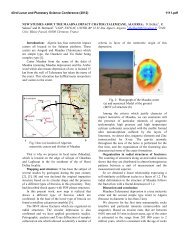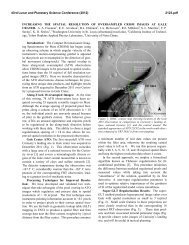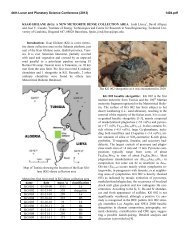Extraction of Meteoritic Metals from Lunar Regolith - Lunar and ...
Extraction of Meteoritic Metals from Lunar Regolith - Lunar and ...
Extraction of Meteoritic Metals from Lunar Regolith - Lunar and ...
You also want an ePaper? Increase the reach of your titles
YUMPU automatically turns print PDFs into web optimized ePapers that Google loves.
44th <strong>Lunar</strong> <strong>and</strong> Planetary Science Conference (2013)<br />
EXTRACTION OF METEORITIC METALS FROM LUNAR REGOLITH<br />
Jayashree Sridhar 1 , B. L.Cooper 2 <strong>and</strong> David S. McKay 3 , 1 Department <strong>of</strong> Aeronautical Engineering, HITS,<br />
(jayashreesridhar@live.com) 2 Cooper Research, League City, TX, 3 NASA Lyndon B. Johnson Space Center, Houston TX.<br />
Introduction: We have begun a series <strong>of</strong> new<br />
experiments, the aim <strong>of</strong> which is to develop methods<br />
<strong>of</strong> magnetically separating meteoritic metals <strong>from</strong><br />
lunar soil. To our knowledge, no other attempts have<br />
been made to accomplish this. The task is daunting<br />
because meteoritic metals are not the only<br />
magnetically-susceptible materials in lunar soil. It is<br />
known [1] that pure metallic iron exists in the soil in<br />
the form <strong>of</strong> nanophase iron globules (npFe 0 ) in the<br />
rims <strong>of</strong> soil grains, <strong>and</strong> that lunar soil as a whole seems<br />
to be magnetically susceptible [2]. Moreover, while<br />
the amount <strong>of</strong> pure meteoritic metal increases with<br />
decreasing grainsize, the amount <strong>of</strong>npFe 0 also<br />
increases with decreasing grainsize[3-5].<br />
RESULTS:<br />
Magnet<br />
Configurations<br />
Test 1:-<br />
Twomagnets<br />
immersed in IPA<br />
with sample<br />
Test 2:- One<br />
magnet outside<br />
the glassware<br />
Test 3:- One<br />
magnet at 3.5 cm<br />
<strong>from</strong> glassware<br />
Test 4:-Four<br />
magnets (two<br />
stronger,two<br />
weaker)<br />
Experimental Set-up: Our experiments involved<br />
placing magnets <strong>of</strong> various strengths at varying<br />
distances <strong>from</strong> a lunar soil sample which was<br />
immersed in isopropanol (IPA). In most tests, magnets<br />
were arranged in a horizontal plane at the height <strong>of</strong> the<br />
side arm <strong>of</strong> a modified Dean-Stark apparatus, which<br />
was filled with isopropanol to a level slightly higher<br />
than the magnets. The stopper <strong>of</strong> the side-arm held a<br />
piece <strong>of</strong> carbon tape. The configurations were<br />
maintained for 30 minutes to an hour, after which the<br />
carbon tape was removed <strong>and</strong> prepared for Scanning<br />
Electron Microscope (SEM) examination. Four<br />
different magnet configurations were used.SEM<br />
studies were performed <strong>and</strong> the amounts <strong>of</strong> meteoritic<br />
metal <strong>and</strong> npFe o -rich grains were determined by grain<br />
counting.<br />
The configurations, samples used, run numbers,<br />
<strong>and</strong> data obtained are given in Table 1.<br />
Samples Run #<br />
Size-fractionated dust (median diameter 3.0<br />
micrometers) <strong>from</strong> lunar soil 14003, 96.<br />
Size-fractionated dust (median diameter 3.0<br />
micrometers) <strong>from</strong> lunar soil 14003, 96.<br />
Size-fractionated dust (median diameter 3.0<br />
micrometers) <strong>from</strong> lunar soil 14003, 96.<br />
Size-fractionated dust (median diameter 3.0<br />
micrometers) <strong>from</strong> lunar soil 14003, 96.<br />
Material ground to a median size <strong>of</strong> 2.2<br />
micrometers <strong>from</strong> lunar soil 14003,96<br />
Size-fractionated dust (median diameter 1.5<br />
micrometers) <strong>from</strong> lunar soil 14003, 96.<br />
Bulk sample 12003,182 (median diameter 16.5<br />
micrometers).<br />
Strong<br />
magnet<br />
Weak<br />
magnet<br />
<strong>Meteoritic</strong><br />
Metal<br />
Grains<br />
# <strong>of</strong><br />
Grains<br />
with<br />
npFe 0<br />
50 251<br />
16 88<br />
1 4 14<br />
2 7 6<br />
1 7 6<br />
1 0 0<br />
2 0 0<br />
1 155 22<br />
2 0 0<br />
3 11 14<br />
4 0 0<br />
1 61 9<br />
2 2 2<br />
3 4 2<br />
4 5 4<br />
1 9 2<br />
2 n.d. n.d.<br />
3 11 8<br />
2276.pdf
44th <strong>Lunar</strong> <strong>and</strong> Planetary Science Conference (2013)<br />
Discussion:Nano-phase iron particles in the samples<br />
were distinguished by their spherical shape with a<br />
strong iron signature in the sample. The npFe 0 globules<br />
were less than 30 nanometers diameter <strong>and</strong><br />
approximately spherical in shape.<br />
Test 1:- Use <strong>of</strong> 2 Magnets Immersed in IPA with<br />
Sample: During the first test, both the strong <strong>and</strong> weak<br />
magnets collected more grains with npFe 0 than grains<br />
<strong>of</strong> meteoritic metal. Moreover, the second run<br />
collected fewer total particles than the first; however,<br />
the relative amounts collected were similar (17 to 15%<br />
meteoritic metal as a percentage <strong>of</strong> total grains<br />
counted).<br />
Test 2: Use <strong>of</strong> a single magnet outside the<br />
glassware: In the second test, we saw slightly more<br />
meteoritic metal (22% <strong>of</strong> the total).<br />
Test 3: Use <strong>of</strong> a magnet at 3.5 cm:-In the third test,<br />
54% <strong>of</strong> the grains were meteoritic material (Figure 1<br />
<strong>and</strong> 2)<strong>and</strong> 46% were npFe 0 -enriched grains (Figures 3<br />
<strong>and</strong> 4).<br />
Test 4: Use <strong>of</strong> fourmagnets (2 stronger <strong>and</strong> 2<br />
weaker):The first attempt with this configuration was<br />
unsuccessful because most <strong>of</strong> the meteoritic material<br />
<strong>and</strong> npFe0-enriched grains had already been removed.<br />
It was visually apparent that the sample was lighter in<br />
color than the starting material, thus we decided to try<br />
other materials with this configuration. Material<br />
ground to a median size <strong>of</strong> 2.2 micrometers <strong>from</strong> lunar<br />
soil 14003, 96 was used[6].<br />
For the first run with this new material, the particles<br />
collected consisted <strong>of</strong> 88% meteoritic metal. In the<br />
second run, few grains were found, possibly because<br />
the carbon tape was in contact with the sample for an<br />
insufficient amount <strong>of</strong> time. There were also particles<br />
in this sample that were not lunar-like. We determined<br />
that some contamination had occurred <strong>from</strong> the SEM<br />
as well as <strong>from</strong> the process <strong>of</strong> removing the carbon<br />
tape with tweezers. In the third run, the percentage <strong>of</strong><br />
meteoritic metal was 44%; however, the overall<br />
particle count was also much reduced in this case (25<br />
grains instead <strong>of</strong> 177 seen in the first run). This was<br />
confirmed by the total absence <strong>of</strong> grains collected on<br />
the carbon tape in run 4.<br />
We next used another size fraction <strong>from</strong> 14003, 96; in<br />
this case with a median diameter <strong>of</strong> 1.5 micrometers.<br />
In this case, on run #1, 87% <strong>of</strong> the grains were<br />
meteoritic metal. We observed again the reduction in<br />
the total number <strong>of</strong> grains after the first run, <strong>and</strong> the<br />
simultaneous decrease in the percentage <strong>of</strong> meteoritic<br />
metal seen in the samples.<br />
The final sample used with this configuration was bulk<br />
soil 12030,183, median diameter 16.5 micrometers. In<br />
the first run, fewer particles were collected than had<br />
been seen in other “first runs”. In other cases the<br />
sample had produced significantly more grains when it<br />
was first used. In this case, the first run collected only<br />
11 particles—however the percentage <strong>of</strong> meteoritic<br />
metal was again quite high: 82%. We obtained no data<br />
<strong>from</strong> the second run because the carbon tape was torn<br />
during removal <strong>from</strong> the glassware. On the third run,<br />
again only a few grains were collected (19); <strong>and</strong> in this<br />
case, the percentage <strong>of</strong> meteoritic metal was 58%, a<br />
reduction which is consistent with the other samples.<br />
It should also be noted that this sample had the largest<br />
median diameter <strong>of</strong> any <strong>of</strong> the samples tried. This may<br />
in part explain the dearth <strong>of</strong> small particles on the<br />
carbon tape.<br />
Figure1:- SEM<br />
image <strong>of</strong><br />
meteoritic Iron.<br />
Figure3:- SEM<br />
image <strong>of</strong> npFe 0<br />
Figure2:- Corresponding spectra <strong>of</strong> the image<br />
on the left.<br />
Figure4:- Corresponding spectra <strong>of</strong> the npFe 0.<br />
Conclusions: -<br />
Experimental results indicate promise for the<br />
extraction <strong>of</strong> meteoritic metals <strong>from</strong> lunar regolith.<br />
However, more work is needed to refine the technique<br />
<strong>and</strong> underst<strong>and</strong> more about the variables that affected<br />
our results.<br />
Acknowledgements: This work evolved <strong>from</strong> my<br />
internship at NASA-Johnson Space Center in Planetary<br />
Dust Lab <strong>and</strong> Scanning Electron Microscope facility. I<br />
would like to thank my advisor Dr. Bonnie Cooper for<br />
giving me support <strong>and</strong> encouragement. I also extend<br />
my gratitude to Dr.Dave McKay <strong>and</strong> Dr.Daniel Ross.<br />
References:<br />
1.Keller, L.P., S.J. Wentworth, <strong>and</strong> D.S. McKay,<br />
Workshop on New Views <strong>of</strong> the Moon Abs. # 44<br />
(1998).<br />
2.Taylor, L.A. <strong>and</strong> D.S. Taylor, Abs. # (2005).<br />
3.Basu, A., S.J. Wentworth, <strong>and</strong> D.S. McKay,<br />
<strong>Meteoritic</strong>s& Planetary Science, 37(Supplement,<br />
p.A13) (2002).<br />
4.Taylor, L.A., et al., Journal <strong>of</strong> Geophysical<br />
Research, 106(E-11): p. 27985-28000 (2001).<br />
5.Taylor, L.A., et al., <strong>Lunar</strong> & Planet. Sci. 34th Abs. #<br />
1774 (2003).<br />
6.Cooper, B.L., et al., Earth & Space 2010, (2010).<br />
2276.pdf


